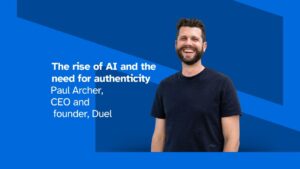Optable‘s Co-founder Vlad Stesin and recently appointed Chief Revenue Officer James Prudhomme chat with NDA about how data clean rooms delivering privacy-first, cookieless activation are the future of digital advertising.
As Optable enters the European market, tell us more about who you are.
Vlad Stesin: Before setting up Optable, I was a co-founder of the Canadian DSP AdGear, which Samsung acquired in 2016. When we founded Optable in 2020, twodisruptive developmentsin the advertising industry shaped our thinking. Firstly, the increasing prominence of privacy features being integrated into web browsers, devices and platforms at a time when the building blocks of digital advertising – third-party cookies and device identifiers – were being dismantled. Secondly, the impact that data protection legislation was having on advertising globally.
What was clear was that advertising needed a new solution to allow data to be connected in a privacy-centric way so publishers, agencies and advertisers could still benefit from data-driven advertising in the future.
So, how will the impact be felt within the ad industry?
James Prudhomme: If you look at digital advertising, traditionally data has been activated on the buy side. Today, this balance of power is shifting to the publishers. Legislation and the eventual demise of third-party cookies are resulting in publishers having a renewed focus on first-party data.
But as custodians of this critical audience data, they need the means to realise its value. Activating their first-party data requires publishers to connect their audiences with advertisers. Only then can they achieve their ambition of maximising the value of their data.
How do data clean rooms slot into the evolving digital marketing business?
VS: Data clean rooms foster collaboration between all players in the advertising ecosystem. As people will know, a data clean room is like a safe house for data. It allows businesses to share and connect their audience data securely and in a way that is privacy-preserving. So clean rooms are really emerging as a viable alternative ina post-cookie world and,in that capacity, they’re helping rebuild trust across the industry and ensure data-driven advertising continues to flourish, even in the face of massive changes.
What are their various applications in digital advertising?
VS: Firstly, it’s around campaign planning. Using our clean room, a publisher can onboard their first-party data and connect it to an advertiser’s customer data. The advertiser can then understand the overlap between their audience and the publisher’s audience. The publisher can also choose to share insights about the audience allowing the advertiser to build a more complete picture. These insights can then be used for honing campaign targeting or finding new lookalike customers.
The second is activation. Once the publisher and advertiser have agreed on an audience, the audience can then be pushed into an ad delivery platform. This can be done directly through our platform by signalling the ad-server using a key value or a deal ID. This ensures the ID’s themselves are never shared and both sides maintain sovereignty over their data.
And finally, analytics for attribution. Publishers can quickly identify which of the advertiser’s customers were exposed to an ad, and the brand can link this to who has converted. Previously, that would have been done using cookies and identifiers, and now obviously that’s not going to be possible.
JP: What we’re doing is essentially rewiring how ad tech operates so the benefits of data-driven advertising can be preserved in a post-cookie world. And we’re making it easy by ensuring frictionless collaboration.
Do both publisher and brand need to be clients of yours to work together in a data clean room?
JP: Good question. Our approach is built around open-sourcing and interoperability. Only one party needs to be a client of our platform. The partner they want to connect with downloads our open-source software, and can then collaborate via clean rooms whilst benefiting from all the same privacy and security features.
Secure sharing of data is obviously necessary now, but is this all leading to a far more fragmented data world, and are there implications to that?
VS: I see it not as fragmented but decentralised. The current generation of ad tech has all been about centralising data. And what’s been the result? A few giant tech companies now dominate advertising.
We’re challenging the notion that centralised is better. By helping connect this huge, dispersed data ecosystem that exists across brands, publishers and partners, these decentralised fortresses of data can become genuine alternatives to today’s centralised walled gardens.
JP: And we are also changing the nature of this kind of data collaboration. In the past, publishers have been disempowered by walled gardens like Google, Facebook or Amazon. Now we’re empowering independent publishers to build their own walled gardens and collaborate with brands by offering their own data hubs.
The concept of data clean rooms is reasonably new. How quickly is the market catching on?
VS: Really very fast. 2022 is the year of the data clean room because it is emerging as a vital alternative in a post-cookie world. Every publisher with sizable programmatic revenues that rely on targeting audience segments via third-party cookies is wrestling with the challenge of protecting that revenue in the future. Clean rooms have a significant role to play here by allowing them to secure that revenue while continuing to offer buyers data-driven precision targeting.
JP: There’s enormous potential, even though we’re still in the early stages of adoption. Whether it’s traditional advertising or channels like retail media or CTV, what can be accomplished with data collaboration and safe, secure data-matching in clean rooms is very powerful. And it’s going to take the industry to whole new heights, well beyond what has been possible.









